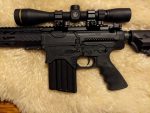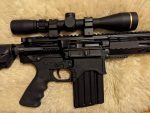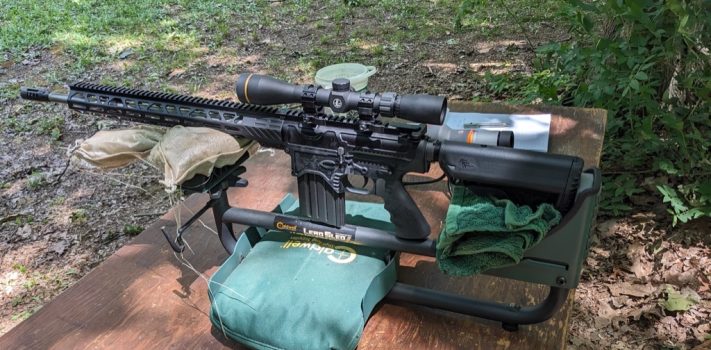The Rock River Arms LAR-BT3 in 6.5 Creedmoor provides an accurate, well-crafted, and robust firearm with moderate recoil and a generous magazine capacity chambered for a versatile and highly effective cartridge.
If you are looking for a semi-automatic rifle with more power than one chambered in 5.56 NATO, less recoil than one chambered in .308 Winchester, and a magazine capacity greater than 10 rounds, the LAR-BT3 in 6.5 Creedmoor might just hit the sweet spot for you.
The particular model that I tested is the Predator HP65C with the muzzle brake. Like many of the best firearms in the world, it is made in the USA. It has a 20 inch cyrogenically treated fluted stainless steel barrel, an M-LOK compatible 17 inch free float rail handguard, a 6 position buttstock, and a Hogue rubber pistol grip. The HP65C cost $1,850 at www.rockriverarms.com at the time of this writing.
Background
Rifles chambered in 5.56 NATO are undeniably popular. But is it also undeniable that the 5.56 NATO cartridge is a bit on the anemic side for most medium to medium-large sized game, especially over longer ranges. As a result, the game regulations of many states do not allow the cartridge to be used for the hunting of deer or similar medium to large-sized game.
Rifles chambered for full-powered cartridges like the .308 Winchester, .30-06 and similar cartridges hit harder and provide greater penetration and longer range than rifles chambered for intermediate cartridges like 5.56 NATO. But full-powered rifles also tend to produce just enough recoil to make many firearm owners hesitant to train with the firearms as faithfully as they should.
Rifles chambered in 6.5 Creedmoor and similar cartridges like 6.5 Swedish attain what for many shooters is a happy medium between 5.56 NATO and .308 Winchester. They provide more power and longer range than 5.56 NATO, while producing less recoil than .308 Winchester. The higher ballistic coefficient of the 6.5 Creedmoor also gives it more accuracy than the .308 at longer ranges. That higher ballistic coefficient also allows 6.5 Creedmoor projectiles to retain more kinetic energy at longer ranges than .308 Winchester projectiles of similar weight.
Although it is not yet as popular as 5.56 NATO and .308 Winchester, 6.5 Creedmoor ammo is also available in a wide variety of loads. For example, I recently compared the number of offerings for ammo in a number of popular chamberings on cheaperthandirt.com. There were 149 varieties of .223 and 5.56 NATO loads, 146 varieties of .308 Winchester and 7.62X51 NATO loads, and 109 varieties of 6.5 Creedmoor loads. This gives the 6.5 Creedmoor a greater variety of readily available loads than even long-time favorites like the .243 Winchester with 77 loads and the .270 Winchester with 76 loads. By way of comparison, the otherwise very attractive 6.5×55 Swedish Mauser was only available in 16 different loads.
As a result of all of these factors, 6.5 Creedmoor has become my preferred chambering for rifles intended for medium to medium-large sized game. So when I saw that Rock River Arms offered their LAR-BT3 chambered in 6.5 Creedmoor, I wanted to take a closer look. I contacted Rock River Arms, and they were kind enough to loan me a sample for testing and evaluation.
First Impressions
 The LAR-BT3 comes in a good, sturdy, foam-lined plastic case with metal latches. That case is orders of magnitude better than the cardboard boxes in which most rifles are shipped. The only drawback with the case is that it is just a little too short to accommodate the rifle when it is fully assembled. To my way of thinking, that defeats the purpose of having such a nice case. It is true that it is not difficult to separate the upper from the lower on the LAR-BT3. But if the case was just a few inches longer, it would not be necessary to disassemble the rifle in order to transport it using the case.
The LAR-BT3 comes in a good, sturdy, foam-lined plastic case with metal latches. That case is orders of magnitude better than the cardboard boxes in which most rifles are shipped. The only drawback with the case is that it is just a little too short to accommodate the rifle when it is fully assembled. To my way of thinking, that defeats the purpose of having such a nice case. It is true that it is not difficult to separate the upper from the lower on the LAR-BT3. But if the case was just a few inches longer, it would not be necessary to disassemble the rifle in order to transport it using the case.
 The case contained a well-oiled upper securely wrapped in foam and plastic, a well-oiled 20-round metal magazine, a well-oiled lower securely wrapped in foam and plastic, and a plastic bag containing a number of items. Those items included an empty chamber flag that can also be used as an assembly/disassembly tool for the rifle, a Rock River Arms sticker, a card warning that the rifle might not be legal in all jurisdictions, a card warning that the rifle should be fed rounds from the magazine only and never from the ejection port, an assembly instruction card, and the manual.
The case contained a well-oiled upper securely wrapped in foam and plastic, a well-oiled 20-round metal magazine, a well-oiled lower securely wrapped in foam and plastic, and a plastic bag containing a number of items. Those items included an empty chamber flag that can also be used as an assembly/disassembly tool for the rifle, a Rock River Arms sticker, a card warning that the rifle might not be legal in all jurisdictions, a card warning that the rifle should be fed rounds from the magazine only and never from the ejection port, an assembly instruction card, and the manual.
The rifle seemed to be well-designed and solidly constructed with excellent fit and finish. The component materials were sturdy, well-selected for their use, and skillfully machined with no extraneous tool marks or other blemishes.
The safety and magazine releases were well-placed and functioned smoothly and effectively. The magazine was easy to load, easy to insert, easy to eject, and fed smoothly and consistently throughout the testing process.
 The 6-position buttstock made adjusting length of pull extremely easy. There was no adjustment for comb height, but I found that careful scope-ring selection provided me with an excellent cheek weld on the comb. The trigger consistently broke crisply and cleanly. I tested trigger pull weight with a Ready Up Gear Digital Trigger Pull Weight Gauge. My 5 readings ranged from 3.23 pounds to 4.76 pounds, with the average and median both coming in at 4.06 pounds.
The 6-position buttstock made adjusting length of pull extremely easy. There was no adjustment for comb height, but I found that careful scope-ring selection provided me with an excellent cheek weld on the comb. The trigger consistently broke crisply and cleanly. I tested trigger pull weight with a Ready Up Gear Digital Trigger Pull Weight Gauge. My 5 readings ranged from 3.23 pounds to 4.76 pounds, with the average and median both coming in at 4.06 pounds.
The rifle functioned smoothly and consistently throughout the testing period with no failures of any kind.
Reading the Manual
I know that many hold to the theory, “If at first you don’t succeed, try, try again. If you don’t succeed after dozens and dozens of attempts, then maybe it is time to read the manual.” I recommend starting with the manual instead. The technical writers of most firearms companies do an excellent job of providing helpful information specific to their particular firearm. The LAR-BT3 manual is no exception. It consists of 60 pages (including the front and back covers) of helpful information that is well written and well illustrated. Here are just a few tidbits:
- Basic safety guidelines are placed near the front of the manual where they can be absorbed before the mind becomes overwhelmed with too much other data.
- They warn that it is vital to make sure that the cam pin is installed in the bolt group. Otherwise the rifle may explode when fired.
- The directions for dealing with hang fire on page 7 differ from the directions on page 8, and both sets of directions differ from the directions on page 11.
- They provide excellent function testing procedures to use following the reassembly of the rifle.
- The warranty is voided by the use of foreign manufactured ammunition, steel-cased ammunition, lacquer-coated ammunition, and reloaded ammunition. The fingerprints of lawyers are clearly on display here.
- They recommend cleaning the rifle before first use.
- “When you must use the forward assist, it is usually time to clean your rifle.”
- “In the unlikely event of an out-of-battery detonation of a round, the firearm is designed to force the generated blast downward through the magazine well.”
- If a squib results in a projectile lodged in the bore, “do not attempt to remove it. Contact Rock River Arms.”
- The cleaning directions are extensive, clear, and well-illustrated.
- The barrel is lapped at the factory.
Initial Cleaning
 Following the directions in the manual, I removed the magazine, separated the upper and lower receivers, removed the buffer and the buffer spring, removed the charging handle and the bolt carrier, removed the firing pin retaining pin and the firing pin, and removed the bolt cam pin and the bolt. It was not necessary to remove the extractor because it moved freely.
Following the directions in the manual, I removed the magazine, separated the upper and lower receivers, removed the buffer and the buffer spring, removed the charging handle and the bolt carrier, removed the firing pin retaining pin and the firing pin, and removed the bolt cam pin and the bolt. It was not necessary to remove the extractor because it moved freely.
I then swabbed the barrel with patches soaked in OGRE Manufacturing Enviroclean FA Gun Cleaner. When the patches came through clean, I followed them with a dry patch to remove excess solvent. I then ran a patch through the barrel to leave a light film of Breakfree CLP. I followed a similar process with the accessible surfaces of all metal parts, reassembled the rifle, and finished up by applying the same process to the exterior of the rifle.
Mounting a Scope
I mounted a Leupold VX-Freedom 3-9X40mm Hunt-Plex scope on the rail on the handguard. The Leupold Rifleman medium rings that I initially used were too low, so that it was difficult to attain a sight picture through the scope. I switched to a slightly higher set of generic rings that I had on hand. Those rings worked perfectly. I then set the proper eye relief, leveled the scope, and evenly tightened the rings.
Range Session 1
 It was a beautiful, sunny day. The temperature was 80 degrees Fahrenheit. A variable breeze was blowing from the south. I made my way to the improvised range behind my pole barn. I set up a target stand in front of the back stop, and then set up a table 25 yards away. I placed a lead sled and a spotting scope on the table along with the rifle and ammo.
It was a beautiful, sunny day. The temperature was 80 degrees Fahrenheit. A variable breeze was blowing from the south. I made my way to the improvised range behind my pole barn. I set up a target stand in front of the back stop, and then set up a table 25 yards away. I placed a lead sled and a spotting scope on the table along with the rifle and ammo.
I chambered a single round of Sellier & Bellot 131 grain SP. That first bullet struck about 0.75 inches high and 0.75 inches to the right of the point of aim. That was close enough that I loaded and fired 2 more rounds which produced a 0.3 inch 3 shot group.
I then adjusted the scope over the course of some additional 3 shot groups in order to zero the scope a little more precisely.
The muzzle brake produced much less excess noise than is typical for such a device. The difference was so pronounced that I initially misidentified the device as a flash hider rather than a muzzle brake. I even left the device on for my later testing at an indoor range, and did not notice excessive noise there, either.
The groups I was shooting gradually became slightly larger, either because the barrel was getting warm, or because I was getting sloppy. My final 3 shot group of the day was the largest at 0.74 inches in size. By that time the zero was pretty good, so I decided that the preliminary work was done and called it a day.
Range Session 2
I traveled to the 100 yard indoor range of the local rod and gun club. There I loaded a single round of Winchester Target & Practice 125-grain Open Tip Range ammo. At 100 yards the bullet struck the cardboard above the paper target.
I pulled the target back to 50 yards, and tried another single round of the Winchester ammo. It struck about 4 inches above the point of aim. I adjusted the scope, and the next round hit about 2 inches low. I adjusted the scope, moved the target to 75 yards, and hit about 1 inch low.
Then I moved the target out to 100 yards and fired 3 rounds of the Winchester ammunition. It produced a 1.49 inch group. I then tried groups with Norma Whitetail 140 grain, Hornady American Whitetail 129 grain InterLock, and Hornady Match 140 grain ELD Match. A Hornady American Whitetail group tied the Winchester group at 1.49 inches in size, while the Hornady Match ammo produced the worst group of the session at 2.05 inches. The average of all the groups I shot ended up being 1.66 inches in size.
The rifle is a bit on the heavy side at 9.1 pounds. During my pre-cleaning, I noticed that most of this weight was concentrated in the bolt carrier group. That weight, the gas-operated semi-automatic action, and the muzzle brake did a great job of absorbing felt recoil. This resulted in a remarkably comfortable range session.
Conclusions
The Rock River Arms Predator HP 65C in 6.5 Creedmoor is guaranteed to produce 1 MOA accuracy at 100 yards. I achieved close to that level of accuracy in my testing. Since I am not the world’s best bench rest shooter, I have no doubt that the rifle is capable of 1 MOA accuracy in the right hands.
I have achieved higher levels of accuracy with other rifles. So if I was looking for a rifle for competitive target shooting, I would pick another. For almost any other task for which 6.5 Creedmoor is an appropriate chambering, I believe this rifle would do an outstanding job.
Due to its weight, I would not be excited about carrying this rifle long distances in the field. But to be fair, the HP65C is slightly lighter than comparable rifles like the M1A, FAL, or PTR-91.
So if you are looking for a rifle that hits harder than one chambered in 5.56 NATO and recoils less than one chambered in .308 Winchester, the HP 65C in 6.5 Creedmoor is definitely a viable option.
Disclaimers
Rock River Arms loaned me a sample of their Predator HP 65C in 6.5 Creedmoor for testing and evaluation. Ready Up Gear provided me with a sample of their Digital Trigger Pull Weight Gauge for a previous article. OGRE Manufacturing provided me with a sample of their Enviroclean FA Gun Cleaner for a previous article. I tried not to let the kindness of these vendors cloud my objectivity, and I believe that I have succeeded. I did not receive any other financial or other inducement to mention any vendor, product, or service in this article.










